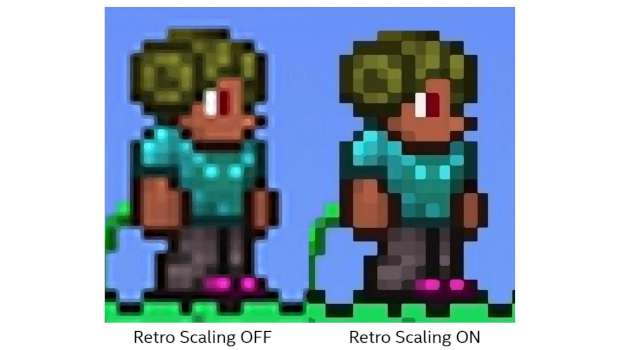
Intel adds ‘retro scaling’ to Ice Lake CPUs to make pixel-art games look more crisp on modern displays
Retro-gaming enthusiasts just received a big gift from Intel, but they’re going to need some new hardware to take advantage of it. The company’s graphics division released beta drivers that enable integer-scaling support in its newly released Ice Lake 10th-gen Core mobile processors.
Intel’s Ice Lake chips put the pedal to the metal when it comes to graphics performance, but integer scaling makes games with limited resolution options look better on modern displays. Upscaling retro games – or retro-styled games with fixed resolutions, like FTL – can result in soft, blurry images when they’re processed using traditional scaling methods. Intel’s driver adds the company’s new ‘retro-scaling’ feature, which offers both true integer scaling as well as ‘nearest-neighbor interpolation’ to crisp up your image on modern displays.
The driver’s release notes detail the settings activating each option in the Intel Graphics Command Center, and the pros and cons of both integer scaling and NN interpolation:
Off: This applies standard display scaling, which can make pixel-art graphics look fuzzy on modern displays.
Fixed width: This is what is commonly referred to as ‘integer scaling’ and will deliver optimal sharpness but may lead to sub-optimal display area utilisation when there is a mismatch between the aspect ratios of the game content and the display.
Scaled Width: This is known as ‘nearest-neighbor interpolation’ and delivers similar benefits to the fixed width option, but in instances where the display’s aspect ratio and the game content do not match, this will scale the content to better utilise display area. This setting may introduce slight distortions in such scenarios due to the application of fractional scaling.
If you’re a retro-gaming or image-scaling geek, you can find a lot more details in the integer scaling support primer that Intel released in mid-July, when Intel graphics and software VP Lisa Pearce vowed to bring integer scaling to the company’s hardware. Retro-gaming enthusiasts had begged Nvidia and AMD to support integer scaling for years prior to Pearce’s promise, but those pleas fell on deaf ears. A mere two weeks ago, however, Nvidia added integer scaling to its GPUs as well as part of a massive Gamescom driver. That gave Nvidia bragging rights as the first major graphics provider to unlock the feature, but it’s hard to imagine that it would’ve been unlocked unless Intel signed up first.
Don’t hold out hope for integer scaling coming to older graphics chips, though. Pearce said that sadly, the Gen9 graphics found in Intel CPUs prior to the new Ice Lake chips can’t support the technology, and Nvidia’s implemention was similarly limited to current-gen “Turing” GeForce graphics cards as well. AMD’s Radeon Technologies Group has yet to announce any plans to support the feature.
Comet Lake processors built using the 14nm manufacturing process were not listed as compatible with integer scaling. Only 10nm Ice Lake CPUs can take advantage of the feature – but both Ice Lake and Comet Lake are sold under the same ’10th-gen Core’ branding. If Intel’s new retro-scaling feature is a must-have feature for you, be sure to check the processor type carefully.
IDG News Service






Subscribers 0
Fans 0
Followers 0
Followers